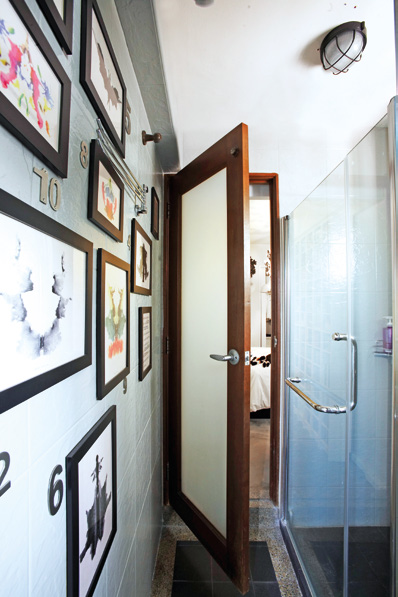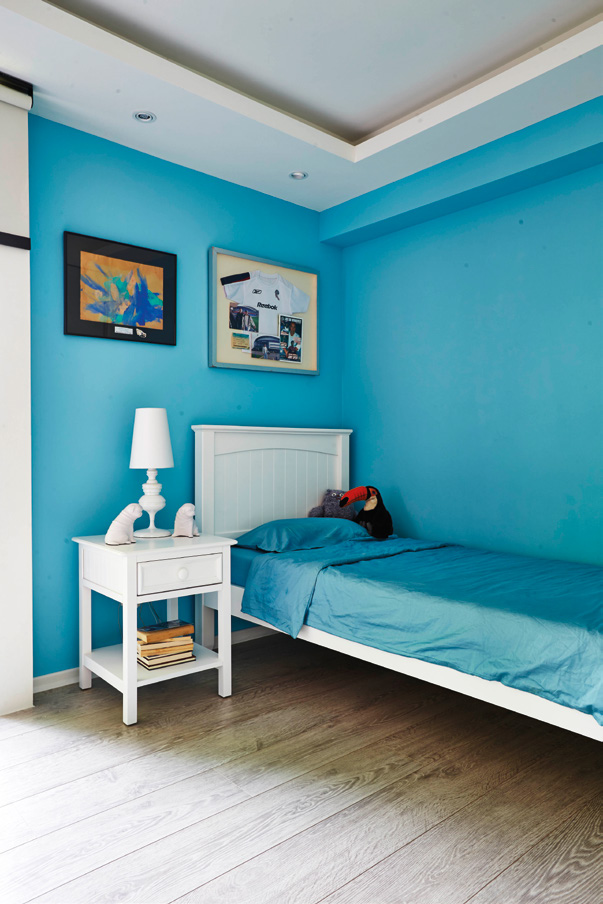Q: We installed slate tiles in our bathroom 20 years ago. Recently ,small bits and “thin slices ” have fallen off. Why is this happening ,and what can we do to keep the tiles from wearing down?


Q: We installed slate tiles in our bathroom 20 years ago. Recently ,small bits and “thin slices ” have fallen off. Why is this happening ,and what can we do to keep the tiles from wearing down?

A : A popular choice for bathrooms 20 to 30 years ago for its tropical resort-style aesthetics, slate (a type of quartz) is a sedimentary stone that is naturally flaky, says Terry Tan of Rice Fields. “Layers of the rock face will come off over time, which is normal in natural tone.” Terry explains that there is no point restoring the relatively inexpensive materials, as the flaking cannot be resolved. In fact, with better alternatives such as more durable lookalike homogeneous tiles in the market, the use of natural slate has been phased out. However, if you want to maintain your slate surfaces, you can apply a sealer. But if the slate is underfoot, it’s best to replace the floor to prevent your feet from being cut by the uneven surfaces
Q: I live in a HDB flat .Lately ,some concrete pieces have been falling from my ceiling .What is causing this problem , and how do I fix it ?
A : This is known as spalling, and it happens when steel bars embedded in the ceiling start to corrode, causing the concrete to crack and fall off in chunks. This usually happens in old buildings. This deterioration is called carbonation, and it could be caused by a humid environment, where moisture and carbon dioxide enter the concrete and cause the steel parts to rust. Spalling concrete won’t affect the structural integrity of the building if it’s repaired quickly; leave it, and it might spread and weaken the building structure. A general contractor should be able to repair your ceiling. To prevent this from happening again, the HDB recommends painting your ceiling with goodquality paint every three to five years, to seal cracks and also holes that have no use, as well as provide sufficient ventilation for the area.

Q: Each time I return from a holiday, I find that cockroaches and ants have invaded my home even though there was no food left out in the kitchen, and all gutter traps had been covered. How can I prevent this?
A : Learning how these pests get into our homes, and removing the elements that attract them, may offer some help. You might have covered the gutter trap and shut the bin chute, but because cockroaches have flat bodies, they are able to slip through any cracks or gaps around bin chutes or doors, says Lim Min Hui, operations director of Rentokil Initial Singapore. She says that cockroaches are drawn to moist conditions so, as a preventive measure, fix any leaking taps and clean hard-to-reach areas behind cabinets or the fridge. Before going on a holiday, homeowners should seal their home’s bin chute cover to prevent cockroaches from entering. Ants also tend to appear in damp, moist areas. Check moisture sources such as sinks, potted plants and electrical outlets in the kitchen and bathroom for ants’ nests. Seal all cracks in tiles and walls to prevent ants from crawling through. If the problem becomes serious despite all your efforts, consider engaging a pest-control service provider to identify areas prone to infestation, and to use more professional means of luring them out.
Q: Why do our ne wly plastered walls keep cracking , despite being mended ? How do we kno w if the plastering is done correctly , and what can we do to prevent it from cracking again ?
A : Some investigation work is needed before knowing how you can treat the problem. “Different factors cause the plaster to crack, and the type of crack also determines what repair work has to be done,” says a spokesman for White Space Living. “If it’s a new wall constructed with bricks, then I believe it is a hairline crack due to the expansion and contraction of the wall. A new wall needs a certain time to settle down, which could be up to a year or more. The solution is to wait for the cracks to ease, then apply a simple coat of plaster and paint over them. If an existing wall cracks, it could be that the layer of plaster used is too thick. This happens when sometimes the wall isn’t aligned and more plaster is applied to the surface for it to have a nice, flat finish. If it is a hairline crack, you may want to get elastic paint to cover it and then finish off with regular paint.”

Q: I’ve tried unsuccessfully to scrub and bleach out the green stuff that gro ws on the edges of the shower screen doors. Any solutions?
A : Your shower screen’s glass panels are probably held in place in their aluminium frames by a clear, elastic epoxy sealant. Many flexible sealants will harden and shrink over time, leaving tiny gaps between the glass and the frames. This “green stuff” is most likely mould growing within or under the sealant, due to the humid conditions in the shower. It’s unhealthy to let bacteriabreeding mould grow freely in places that you and your family use on a daily basis. Scrape out and replace the entire strip of sealant to get rid of the gunk. Before you apply the new sealant, take the opportunity to scrub down the inside corners of the glass and the aluminium frames to get rid of any slimy residue.

Q: Blotchy mould and mildew spots are forming on my bathroom ceiling, especially in the area above the washbasin. I had requested for anti -mould paint to be used on the ceiling, so I’m wondering why this is happening?
A : Although anti-mould paint was used, in cases where there is water leakage or when it’s a poorly ventilated environment, mould and mildew can still form. “If there is no water leakage, scrape away the loose paint before applying Nippon Paint Anti-Fungus solution, or household bleach, and leave it to dry fully. Then apply one coat of sealer, and two coats of anti-mould paint. Improve the ventilation in the space to make sure the problem doesn’t return,” says Shelly Chan from Nippon Paint. Installing a ventilation fan will also help prevent mould. Look out for Nippon Paint’s Odour-less antimould ceiling white paint, which specifically targets problematic areas such as kitchen and bathroom ceilings.

Q: How can I remove stains from a painted wall, such as marks made by crayons, markers , and Blu -Tack?
A : In a home with young children, it’s inevitable that your walls will become convenient canvases for these budding artists. “Common marks can be easily cleaned by wiping with a soft sponge and a little soap solution, says a spokesman for Dulux. You can also try removing crayon and marker stains with baking soda. Sprinkle the powder on a damp cloth, and scrub hard at the stain. Some also swear by toothpaste, which, like baking powder, acts as an abrasive to scrub out the stain. If the marks are on a coloured wall, carry out a patch test on an inconspicuous corner to make sure your chosen method doesn’t remove paint colour as well. Blu-Tack that has been left on a wall for a long time might stain the surface when oil from the pliable putty seeps into the surface, especially if the wall was painted a long time ago and has become porous. To remove these stains, Blu-Tack’s website suggests a citrus-based stain remover. This might remove the paint as well, and your wall will need to be repainted. Why not kid-proof your walls with washable paints instead, and avoid the hassle of cleaning? Both Dulux and Nippon Paints have paints that protect wall surfaces and make stains and marks easy to clean.
Q: Dust is a big problem in my home, how do I keep it dust -free?
A : Do you keep lots of decorative items at home and hoard paper (old newspapers, magazines and books)? Is the majority of your furniture upholstered, and is your closet stacked full of clothing? If you’ve answered yes to these questions, we’re not surprised you have a dusty home, especially when cleaning is not done regularly. Dust is made up of tiny particles of fabric fibres, paper, hair, dead skin, dirt, and so on. It’s important to get rid of dust on a regular basis, as it can cause health problems. To cut down on the dust in your home, clear hard-to-clean items that they can settle on, such as decorative objects. Throw away old paper items (which degenerates), cut down on fabric-covered furniture and other soft furnishings (which dust is attracted to), and clean out your closet (dust falls from your clothes when you open the closet door, just look at the floor of your closet!) Regular cleaning is the key to keeping your home dust-free. Sweep often, vacuum regularly, and wipe down surfaces with a damp cloth or a microfiber cloth, which can trap the smallest dust particles. Bedding should be changed once a week for pillowcases and sheets (don’t leave them longer than two weeks). Once in a while, take your pillows and duvets, as well as seat cushions and rugs, outside and beat them (with a broom stick or pole) to get rid of the dust that has settled on them.

Q: I would love a low-slung upholstered sofa for my living room, but I’m worried about maintenance as I know some upholstery cannot be removed for washing. How do I maintain such sofas?
A : A stitch in time saves nine so, first, prevent stains and spills from ruining your upholstery by using fabric protection and cleaning products found in DIY stores. Some brands even have their own proprietary range of products. Apply them to areas with high bodily contact such as the armrests, backrest and seats. Other than taking precautions when you’re having a meal or snacking while sitting on the sofa (for example, using a plate), regular maintenance is key to keeping your upholstery in good shape. Regularly remove dust from upholstered furniture with a vacuum cleaner using the soft brush nozzle, as fine dust particles can stick to fabric and result in wear, says a representative from Danish furnishings company Boconcept. Boconcept also recommends cleaning pieces of furniture that come into direct contact with skin, at least twice a year to keep the fabric from degrading due to natural body perspiration. Another way to protect the sofa’s armrests is to cover them. Some brands such as Boconcept offer a specially designed tray that fits over the armrest, providing a more stable base for drinks. Alternatively, lay a throw over the armrest or back, which acts as a protective layer and decoration, too.
Q: How do I get rid of the smell that lingers on a leather sofa someone has slept on?
A : As a porous material, leather is affected by its environment and can absorb smells and oils that it comes into constant close contact with. A well-made leather sofa can last a lifetime if it is properly maintained. If your sofa has developed a smell, a spokesman for furniture company Domicil has this advice: “Air it in the open for about 12 to 24 hours. Exposure to sun will banish most odours. If it’s rainy, air it near an open window or doorway with the aid of a fan. Cleaning, polishing and conditioning the leather with a good leather maintenance kit is also effective in removing odours. If these methods don’t work, try putting some baking soda on a thin cloth or mesh and place it on the sofa overnight. The baking soda will absorb the smells.”























